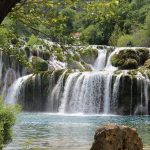January 18, 2020 – Swimming at the famous Skradinski Buk will be no more as of next year.
HRTurizam writes that conserving and protecting natural resources and biodiversity are the main determinants of the new Regulation on protecting and preserving Krka National Park.
At a time when the world is facing the challenges of climate change, sustainability is becoming imperative for future development, especially in tourism, without talking about natural resources such as Krka National Park.
The overall viability of the Krka River basin and its wildlife rests on the development of travertine barriers, so preserving the travertine deposition process is a fundamental goal of Krka National Park.
To implement active conservation and revitalization measures and align cooperation and activities with the local community, the new regulations deliver innovations in line with long-term strategic goals and new sustainable management measures that underpin the future management plan and the pending spatial plan.
For this reason, there will be a swimming ban at Krka National Park from January 1, 2021.
However, since humans have coexisted with the river thus far, swimming will be allowed at the following locations: Stinice, Remetić – Pisak and the downstream of the Roški Slap.
Therefore, swimming at Skradinski buk, which was most attractive to visitors, will no longer be allowed.
“The public institution ‘Krka National Park’, before its 35th birthday, will adopt the most important strategic documents that will determine the path we want to take towards our mature years. What kind of ecosystem we will leave for future generations is our most important task and new regulations have been adopted following it. After many years of deliberation and research, considering the needs of both nature and us, who in one way or another use what Krka has given us, measures have been adopted that will contribute to long-term sustainable management and protecting nature,” said the director of Krka National Park, Nella Slavica, who added:
“The regulations are strongly focused on conserving resources and the richness of biodiversity, whether it concerns regulating visitor numbers, waste disposal, hunting and fishing or deforestation. The manner of using water and public water resources in sub-zones is clearly defined and obliges the users to submit annual work plans following the activities of the Institution.“
The regulations apply to employees of Krka National Park, residents of the National Park, property owners and right holders of real estate in the Park and their family members, natural and legal persons who carry out permitted activities, visitors and other users of the Park space in the area of Krka National Park.
Compared to the old 2011 regulations, the new one also provides a detailed explanation of the Krka National Park zoning, which includes management zones of strict and directional protection, as well as zones of use and subzones of settlements, visitor infrastructure, using natural resources and roads that are under the Management Plan, a 10-year strategy document and a zoning map attached.
https://www.youtube.com/watch?v=v=aIVKO23KqNM
“In the strict protection zone, the goal of management is to preserve natural processes and habitats and their components,” emphasized the expert director of Krka National Park, Drago Marguš, who explained that “the directional protection zone encompasses non-native ecosystems: grasslands, pastures, aquatic habitats, etc., which for the purpose of long-term conservation require active management measures of maintenance or restoration.”
“Active conservation and revitalization measures are allowed in the directional protection zones without which the essential characteristics of the area would be changed. Agricultural activities are allowed by the management objectives for the conservation of biological, geological and landscape values,” emphasized Marguš.
For example, this means that the mowing and traditional grazing of livestock breeds under human control is permitted, except on steep canyon slopes, Skradinski buk and Roški Slap, and visitor infrastructure subzones.
Hunting and fishing, on the other hand, are not permitted activities at the National Park. Because of its geological history, the Krka River is home to endemic fish species, and its banks preserve the habitats of numerous endangered animals. Therefore, it is considered a natural monument of the highest category and should be preserved for the future.
The new regulations, adopted by the Ministry of the Environment and Energy of the Republic of Croatia, were decided on December 21, 2019, which you can read here.
To read more about lifestyle in Croatia, follow TCN’s dedicated page.








